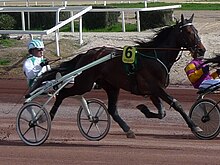Standardbred
The Standardbred is an American horse breed best known for its ability in harness racing, where members of the breed compete at either a trot or pace. Developed in North America, the breed can trace its bloodlines to 18th-century England. The Standardbred is recognized worldwide. They are solid, well-built horses with good dispositions. In addition to harness racing, the Standardbred is used for a variety of equestrian activities — including horse shows and pleasure riding — particularly in the midwestern and eastern United States, and southern Ontario.
In the 17th century, the first trotting races were held in the Americas, usually in fields on horses under saddle. However, by the mid-18th century, trotting races were held on official courses, with the horses in harness. Breeds that have contributed foundation stock to the Standardbred breed included the Narragansett Pacer, Canadian Pacer, Thoroughbred, Norfolk Trotter, Hackney, and Morgan.
The of the Standardbred trace to a Thoroughbred foaled in England in 1780 named Messenger. He was a gray stallion imported to the United States in 1788. He sired a number of flat racing horses, but was best known for his great-grandson, Hambletonian 10, also known as Rysdyk's Hambletonian, foaled in 1849 and considered the of the breed and from whom all Standardbreds descend. Hambletonian 10 was out of a dam with Norfolk Trotter breeding, and the mare and foal were purchased by William Rysdyk, a farm hand from New York state, who successfully raced the colt as a three-year-old against other horses. The horse went on to sire 1,331 offspring, 40 of whom trotted a mile in under 2 minutes 30 seconds.
...
Wikipedia

